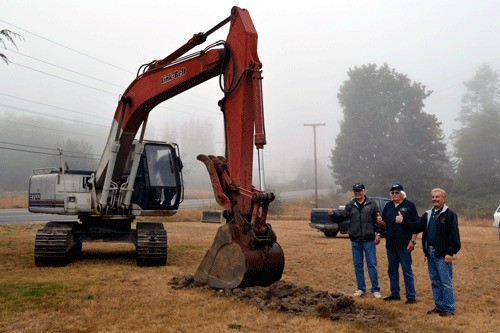One may wonder how a hole in the ground could spark so much joy in the faces of grown men, but that was the case Thursday morning as members of the A-3 Skywarrior Whidbey Memorial Foundation watched ground being broken at the memorial site.
“It’s taken us three years to get to this point,” said Bill Burklow. “Oh, man, it’s awesome.”
“It’s an exciting day,” agreed Jeff Hansen. “It brings us that much closer to the end product.”
The three watched as a backhoe scraped up a bucket of dirt near the center of the space at the corner of Ault Field Road and Langley Boulevard in Oak Harbor, which is near the entrance to the main gate of Whidbey Island Naval Air Station. It is the first physical step in the process of creating a concrete pad that will serve as the foundation for “the Whale,” as the jet is affectionately called.
“We’re looking at about a three-week event here,” said Burklow. “It will take about a week to get it excavated and inspected; then they’ll put down the rebar and pour the concrete. It will take about a week to cure the concrete and then they’ll do a week of testing for weight.”
While the groundbreaking was exciting, moving the aircraft will be the biggest part of the project. The plane will likely be moved in the middle of the night, because it will have to travel down Ault Field Road before it is put in place.
“Even with the wings folded the plane’s still 50 feet wide,” said Jim Croft.
“We’re going to be walking the wings to make sure it’s got plenty of clearance,” said Burklow.
The plane’s tail is also folded to one side, but even so it stands 16-feet, 9-inches tall. Burklow said he believes the clearance for the traffic signals at the intersection by which the plane will be situated is 17 feet, which will likely make for a few anxious moments when moving day does arrive.
This is just the first stage of the memorial’s construction, which is expected to be completed in phases. The plane will initially rest on its tires.
“Eventually it’ll be mounted in a down and dirty (landing) configuration,” said Burklow. “The nose will be up, wheels down, tailhook down — it’ll look like it’s landing on a carrier.”
The first phase will include the excavation for the concrete pad and the sidewalk, which will lead to the CPO Club on Ault Field. A lone tree close to Ault Field Road will be removed for logistical reasons, although Croft has other motives.
“That tree’s gotta go,” he said. “I don’t want any birds making doo-doo on my plane.”
Fowl behavior aside, Croft’s proprietary attitude may stem from the 1,500 hours he invested in restoring the plane. Hansen also donated 1,500 hours to the project and said they couldn’t have finished the job without the help they received from the sailors of VQ-2, Fleet Air Reconnaissance and NAS Whidbey Island.
Their names are painted on either side of aircraft, just under the window, while the names of all the NASWI sailors who helped with the restoration are painted inside a compartment.
The jet has been sitting on the tarmac behind Hangar 9 on the air station since June, ready and waiting to be moved to its final home.
The aircraft sports a new tail, new nose and a lot of new paint.
“That is one big airplane to sand,” laughed Croft.
“We also took the bomb racks off and the wave guide on the side off, because the aircraft that were here didn’t have those,” Hansen said.
“The paint scheme is a link to the past, present and future of electronic attack airplanes,” said Burklow.
On one side, homage is paid to Heavy Attack Squadron (VAH) 123, the training squadron for the A-3 Skywarrior. The other side boasts the sword that was the logo of Heavy-10, the last A-3 squadron on Whidbey.
It was redesignated Electronic Attack Squadron (VAQ) 129 in 1970, helping the Navy transition from the Skywarrior to the EA-6B Prowler. (VAQ-129 continues its retraining mission today as the Navy transitions from the Prowler to the EA-18G Growler.)
The number on the nose of the plane is also unique.
“The number 263 represents the individuals who perished while flying the A-3,” said Burklow.
The men of the A-3 Skywarrior Whidbey Memorial Foundation can’t deny their love of this particular aircraft. The plane holds a different memory for each, but it seems many of those who were part of this era in Naval aviation look back on it fondly.
“Everybody I ever knew who served in an A-3 outfit loved flying Heavy Attack,” Burklow said.
The next phase of the project is the monument. The plans have been approved and it should be done in three or four months, according to Burklow. A dedication ceremony will be held when the entire memorial is complete.



